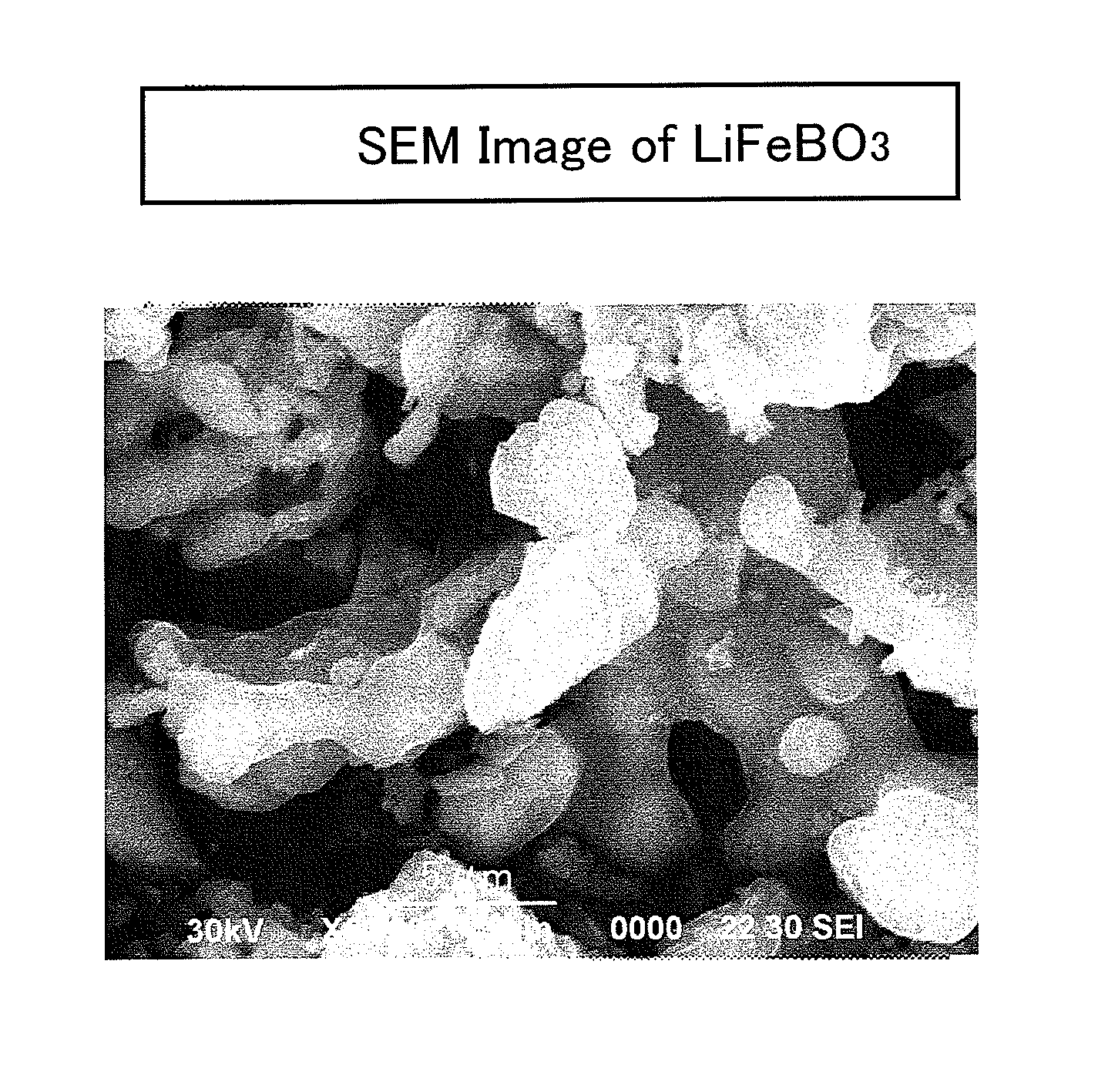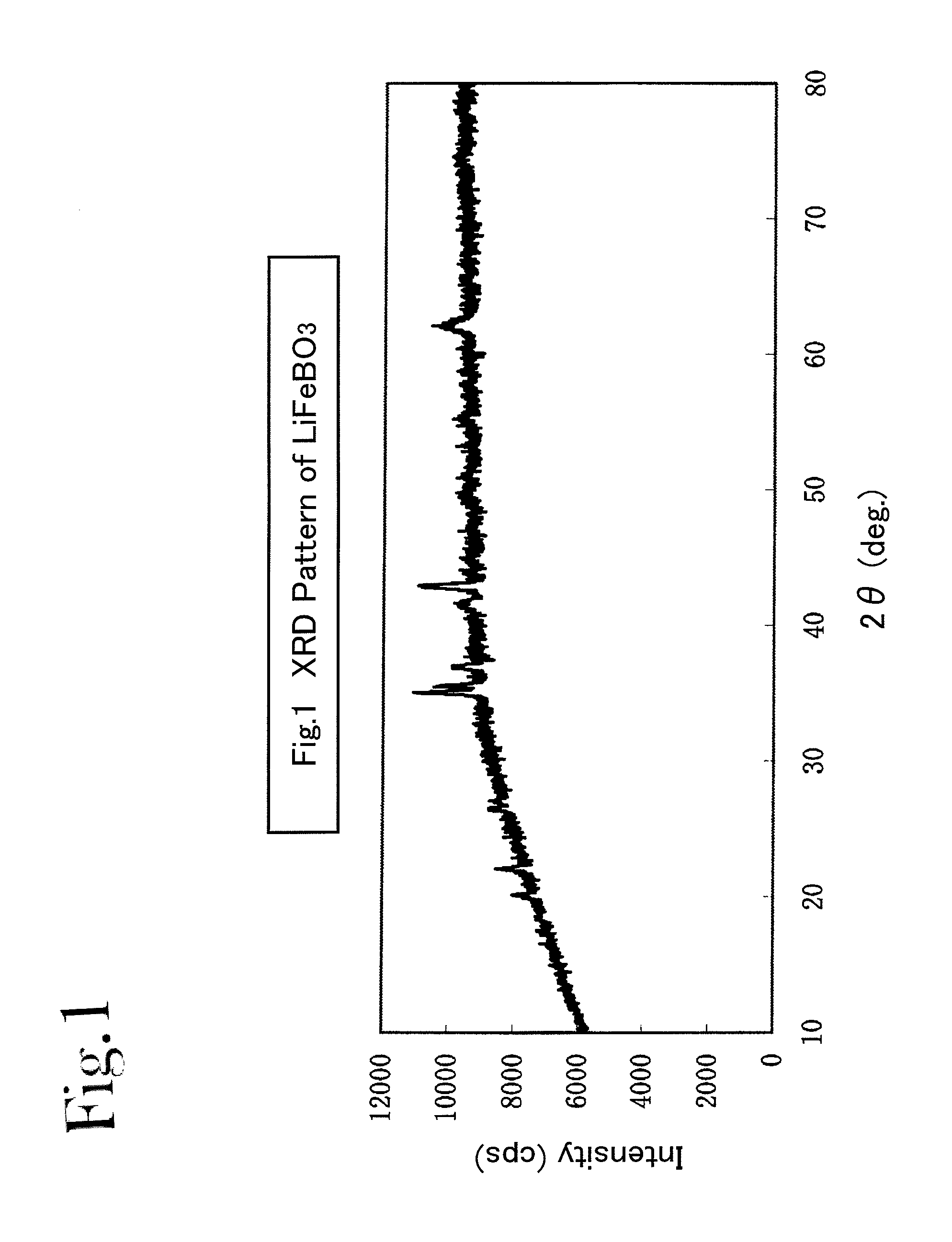Production process for lithium-borate-system compound
a lithium-borate system and production process technology, applied in the field of lithium-borate system compound production, can solve the problems of oxidative exothermic reaction, limited theoretical capacity to 170 mah/g, and inability to withstand the charging voltage of electrolytic liquids, etc., to achieve low environmental load, reduce oxygen elimination, and high capacity
- Summary
- Abstract
- Description
- Claims
- Application Information
AI Technical Summary
Benefits of technology
Problems solved by technology
Method used
Image
Examples
example no.1
Example No. 1
Synthesis of Lithium-Rich Borate-System Compound, and Charging-Discharging Characteristics of Battery Using the Same
[0100]Iron oxalate, FeC2O4.2H2O (produced by SIGMA-ALDRICH, and with 99.99% purity), anhydrous lithium hydroxide, LiOH (produced by KISHIDA KAGAKU, and with 98% purity), and boric acid, H3BO3 (produced by KISHIDA KAGAKU, and with 99.5% purity), were used in an amount of 0.005 moles, respectively, as raw materials; and these were mixed with a carbonate mixture (e.g., one which was made by mixing lithium carbonate (produced by KISHIDA KAGAKU, and with 99.9% purity), sodium carbonate (produced by KISHIDA KAGAKU, and with 99.5% purity) and potassium carbonate (produced by KISHIDA KAGAKU, and with 99.5% purity) in a ratio of 0.435:0.315:0.25 by mol). The mixing proportion was set at such a proportion that a summed amount of the iron oxalate, lithium hydroxide and boric acid was 225 parts by weight with respect to 100 parts by weight of the carbonate mixture.
[01...
example no.2
Example No. 2
[0112]Lithium-rich borate-system compounds, which were expressed by a compositional formula: Li1+a-bAbM1-xM′xBO3+c (in the formula, “A” is at least one element that is selected from the group consisting of Na, K, Rb and Cs; “M” is at least one element that is selected from the group consisting of Fe and Mn; “M′” is at least one element that is selected from the group consisting of Mg, Ca, Co, Al, Ni, Nb, Mo, W, Ti and Zr; and the respective subscripts are specified as follows: 0≦x≦0.5; 0b), were synthesized in the same manner as Example No. 1, except that metallic components being in compliance with target compositions shown in Table 2 below were used along with the iron oxalate that was used in the process according to Example No. 1. Moreover, lithium-rich borate-system compounds, which were expressed by the compositional formula above, were synthesized in the same manner as Example No. 1 except that metallic components being in compliance with target compositions show...
example no.3
Example No. 3
Fluorine Impartation
[0117]50 parts by weight of acetylene black (being represented as “AB” hereinafter) and 20 parts by weight of LiF were added to 100 parts by weight of the products (i.e., lithium-borate-system compounds) that were obtained after water-soluble substances, such as the carbonate salts, had been removed in Example No. 2. Then, they were subjected to a milling process at a rate of 450 rpm for 5 hours with use of a planetary ball mill (with 5-mm zirconia balls), and were then subjected to a heat treatment at 700° C. for 2 hours in a mixed-gas atmosphere of carbon dioxide and hydrogen (e.g. CO2:H2=100:3 by molar ratio) . Since the XRD patterns of the products after the heat treatment agreed well with the XRD patterns of the samples prior to the heat treatment, it was possible to ascertain that the lithium-rich borate-system compounds maintained the crystal structures without ever being decomposed. Moreover, the results of the elemental analysis (i.e., eleme...
PUM
 Login to View More
Login to View More Abstract
Description
Claims
Application Information
 Login to View More
Login to View More - R&D
- Intellectual Property
- Life Sciences
- Materials
- Tech Scout
- Unparalleled Data Quality
- Higher Quality Content
- 60% Fewer Hallucinations
Browse by: Latest US Patents, China's latest patents, Technical Efficacy Thesaurus, Application Domain, Technology Topic, Popular Technical Reports.
© 2025 PatSnap. All rights reserved.Legal|Privacy policy|Modern Slavery Act Transparency Statement|Sitemap|About US| Contact US: help@patsnap.com



